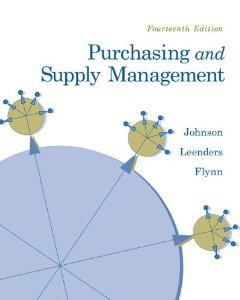Test Bank for Purchasing and Supply Management, 14th Edition P Fraser Johnson
$35.00 Original price was: $35.00.$26.50Current price is: $26.50.
Test Bank for Purchasing and Supply Management, 14th Edition P Fraser Johnson
Test Bank for Purchasing and Supply Management, 14th Edition P Fraser Johnson

People also search:
Purchasing and Supply Management
Purchasing and Supply Management P Fraser Johnson
Purchasing and Supply Management P Fraser Johnson 14
Purchasing and Supply Management P Fraser Johnson 14 Test Bank
Test Bank for Purchasing and Supply Management, 14th Edition P Fraser Johnson Download
Description:
CHAPTER 2
QUIZ RESPONSES
E 1. An effective supply strategy primarily focuses on linking:
a. current needs to current markets.
b. future needs to future markets.
c. current needs to future markets.
d. future needs to current markets.
e. current and future needs to current and future markets.
A 2. Organizational objectives and supply objectives typically are expressed:
a. differently, making it difficult to translate organizational objectives into supply objectives.
b. differently, providing the supply manager multiple opportunities to tap into organizational resources.
c. the same (survival, growth, financial, and environmental), making it easy to translate organizational objectives into supply objectives.
d. the same factors (quality, quantity, price, delivery and service), but long-term at the organizational level and short-term at the supply level.
e. in ways that are very specific to the organization, making it difficult to convey objectives to suppliers.
C 3. Which one of the following is NOT one of the six major supply strategy areas:
a. competitive-edge strategies.
b. environmental-change strategies.
c. new-product design strategies.
d. risk-management strategies.
e. cost-reduction strategies.
A 4. When developing supply strategies related to “how to buy,” decisions must be made
about:
i. systems and procedures
ii. goals and objectives.
iii. make or buy.
iv. large or small inventories.
v. none of the above.
E 5. The key question in strategic supply management is:
a. How can supply strategy be kept separate from and equal to organizational strategy?
b. How can first tier suppliers contribute to the buying organization’s objectives and strategy?
c. How can first, second, third- and subsequent tiers of suppliers contribute to the buying organization’s objectives and strategy?
d. How can the supply manager develop a network of suppliers that contribute to the buying organization’s strategies and goals?
e. How can supply and the supply chain contribute effectively to organizational objectives and strategy?
B 6. Three major challenges exist when setting supply objectives and strategies:
a. adopting efficient electronic transaction systems, designing effective strategic supply processes, and increasing internal compliance with both.
b. effectively interpreting corporate and supply objectives, selecting appropriate actions to achieve objectives, and integrating supply information into organizational strategies.
c. hiring professionals educated specifically in supply management, providing them with technical expertise, and developing leadership skills for the long-term.
d. emphasizing strategic cost management, involving key suppliers early in the process, and measuring the reduction in total cost of ownership.
e. identifying internal stakeholders, building consensus among these stakeholders, and selling top management on the results.
C 7. To effectively manage supply risks, the supply manager must:
a. inform the corporate risk officer of a potential risk, await instructions, and implement the directive.
b. seek input from senior executives in other functional areas, propose a risk mitigation plan, and await instructions from senior management.
c. identify and classify risks, assess the potential impact, and develop a risk mitigation strategy.
d. review the commodity strategy, revise it as needed, and implement the strategy revision.
e. confer with the organization’s management consultant, provide all requested data, and implement the consultant’s plan.
D 8. Linking supply strategy to corporate strategy is:
a. essential only in manufacturing, and most have the mechanisms to link them..
b. essential only in the service sector, and most lack the mechanisms to link them.
c. essential in all organizations, and most have the mechanisms to link them.
d. essential in all organizations, and many lack the mechanisms to link them.
e. non-essential in most types of organizations.
D 9. Strategic planning can be defined as:
a. how each functional area will achieve its specific goals and objectives.
b. a procedure for allocating resources to appropriate functions in the organization.
c. taking big risks to maximize current period benefits.
d. an action plan to achieve specific long-term goals and objectives.
e. an action plan to achieve specific operational and tactical goals.
B 10.
Supply strategies that are based on changes in demand and supply are known as:
a. risk-management strategies.
b. assurance-of-supply strategies.
c. cost-reduction strategies.
d. environmental-change strategies.
e. supply chain support strategies.
True and False
T 1. The three levels of strategic planning are: function, unit, and corporate.
F 2. Environmental-change strategies are designed to anticipate and recognize shifts in the natural world that affect supply availability.
F 3. Even if a supply manager identifies and eliminates the causes of uncertainty and risk in the supply chain, the organization may still need to carry the same amount of inventory.
F 4. Risks in the supply chain can be classified into three main categories: (1) operational, (2) financial, and (3) strategic.
T 5. There is a growing emphasis on strategic supply management processes and less on purchase transactions.
T 6. A corporate risk management group headed by a chief risk officer has emerged in many organizations to assess total risk exposure and develop strategies to best manage all risks.
F 7. Assurance-of-supply strategies emphasize quality over all other considerations.
T
8. The most fundamental question facing an organization is whether to make or buy.
T 9. Supply managers may be able to provide information to identify risks to the organization and they can develop strategies to mitigate those risks.
F 10. Seldom do the actions of supply managers impact the organization’s reputation either positively or negatively.
Related products
Test Bank
Test Bank for Clinical Immunology and Serology A Laboratory Perspective, 3rd Edition: Stevens











